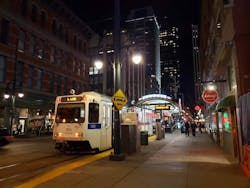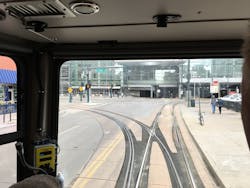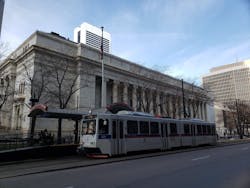Development of a light-rail extension in downtown Denver
The Regional Transportation District (RTD) introduced light-rail transit (LRT) in the Denver region with the opening of the Central Corridor in 1994. This new line included 2 miles of in-street running through central downtown Denver to a northeast terminal along historic Welton Street. More than 20 years and five light-rail extensions later, 14 trains per hour are operating on the downtown loop during peak weekday periods. The RTD Central Rail Extension project is part of the FasTracks transit expansion plan approved by voters in the Denver metro area in 2004. It will connect the Central Line, which currently terminates at 30th and Downing Station, with the University of Colorado A Line, which provides service to Denver International Airport. The A Line opened in April 2016 and continues to see growing ridership.
In 2013, RTD initiated a mobility study to examine operations of the Central Rail Extension. As a result, ideas for improving the other lines that use the downtown loop were introduced. Some of these ideas could have been implemented without the construction of the extension and at a much lower cost than building new infrastructure. Overall, RTD concluded that the extension could have a positive effect on both the current D Line along Welton Street and the entire RTD light-rail system.
As the Central Rail Extension Mobility Study unfolded, RTD marketing efforts for FasTracks branded the extension the “L Line.” However, it was still not officially determined if the extension would be an entirely new line—one running between downtown and the 38th and Blake Station on the A Line—or an extension of the D Line, which then ran from 30th and Downing Station to suburban Mineral Station on the southwest edge of the region. There was speculation that introducing a new line and additional trains through the downtown loop would cause unnecessary complications, especially after the downtown traffic signals were retimed from 75-second to 90-second phases, which reduced the capacity of light-rail transit serving downtown Denver. However, the D Line was facing increased service reliability issues that were a result of the single track along Welton Street. These issues were compounded by a relatively long end-to-end trip time (about 60 minutes), on a route that had to interlace with four other light-rail lines that operate south of Denver.
Prior to the study, there had been improvements to the D Line along Welton Street that included transit signal preemption at one intersection known to cause repeated delays, and the closing of the 29th and Welton Street Station, which was a block away from the northern terminal and helped save about 90 seconds of running time in each direction. The latter modification allowed trains to pass on either end of the single track section through Welton Street. The primary issue with the D Line was that the point on the double track section where the trains would pass before the single track section did not mesh with the timing to operate around the loop and slot in between the other trains. The system had worked well when the D Line was the only line serving downtown, and even when the Southeast Extension opened in November 2006 (adding the F and H Lines through central downtown). However, the retiming of downtown traffic signals in early 2011 created problems.
The study, which included VISSIM microsimulation traffic modeling and support from RTD service and operations planners, determined that a separate L Line could work operationally and would have other advantages as well. To help make this new operation efficient, the study recommended building a new pocket (“turn-around”) track on the south end of the downtown loop so that trains from 30th and Downing could stage for one- or two-signal cycles and get out of the way of other trains running downtown before heading north. When a Transportation Investment Generating Economic Recovery (TIGER) grant application for funding this pocket track fell through in 2014-2015, RTD staff discovered another way to make the L Line work by creatively scheduling it between trains running south and north. The L Line could take the slot of a train that runs from the south to Union Station in one direction, and then take another open slot in the other direction. Before being implemented, the operating concept was field-tested using non-revenue trains. The new L Line concept was essentially an implementation of the Central Rail Extension operations plan without construction of the extension to 38th and Blake Station.
Improvements to the RTD light-rail system
The No. 1 improvement on the L Line is enhanced safety. Because the L Line is a separate operation, light rail operators can be more focused and concentrate on operating vehicles that have to contend with numerous street crossings. Operators on this line also have a greater percentage of recovery and layover time compared to other light-rail lines, which is crucial on a line running on the street with so many street crossings. Accidents between light-rail vehicles and cars happen most often along Welton Street compared to other parts of the system.
Another important improvement is system reliability and on-time performance. With the added stress on the central downtown loop after light-rail extensions and less recovery time because of the longer traffic signal cycles, navigating downtown on time is very important. With all central downtown trains going through the loop from the south, the L Line on its own, and a new and better schedule with improved double track passing on either end of the single track along Welton Street, it is possible to see an increase in on-time performance. Additionally, if an L Line train is running late, another train from the south that gets stuck behind it does not need to follow it for very long and can begin to recover time faster.
There are other advantages aside from safety and operations, including maintenance cost savings such as reducing LRT vehicle miles. The ridership along the Welton Street segment requires one-car trains while the rest of the D Line needs a mix of three- and four-car trains during weekday peak periods. The platform lengths along Welton Street accommodate three-car trains at most, which limits the operation of D Line trains to three-car trains, and requires additional four-car trains on lines such as the F and H to run every 30 minutes and circle the loop. Looking at the ridership on the D Line, if all “base” D Line trains that went to and from 30th and Downing Station were run with four-car consists, additional peak D Line trips could be dropped. This would help balance the number of trains per hour that run through downtown Denver and allow the C Line service (trains running between Mineral Station and Denver Union Station, on the north end of downtown), to be increased. This is important because, in recent years, ridership has been growing for trains that serve Denver Union Station, and decreasing for trains that serve central downtown. Service on the E Line had already been increased to run every 15 minutes in the peak periods and RTD ridership projections predicted similar increases to the C Line would be needed.
These changes to LRT vehicle assignments would lead to an overall savings in annual miles operated. The L Line would cost slightly more to operate because of the additional service through downtown Denver, although the savings in vehicle miles would more than offset the costs. RTD staff created a cost model to compare the slight increase in operating hours against the greater decrease in maintenance hours to forecast a savings of $1.3 to $3.4 million annually. The difference in those numbers depends on how many vehicles are run in an L Line consist. Initially, the L Line operated with two-car trains, which led to the $1.3 million a year savings figure. Now, the L Line operates with one-car trains, which results in an annual savings nearer to the $3.4 million figure. Another positive aspect of running one-car trains through the Welton Street area is that they are more appropriate for the neighborhood.
Finally, a lasting benefit of the L Line introduction is increased flexibility for future service possibilities. By putting the L Line on its own route, it is possible to more easily implement the Central Rail Extension as the operations plan for mixing in with the other light-rail trains in the downtown loop has been implemented. If the Central Rail Extension is indeed mixed with street traffic along Downing Street between the 30th and Downing Station and the 38th & Blake Station, it should not have a negative effect on the other trains running through downtown Denver. The L Line opens other possibilities as well, such as someday running low-floor vehicles (more like modern streetcars seen in many cities today) on the line, which are also more fitting for the neighborhood, and more in line with the trains performing as a lower volume streetcar line, which is essentially how they already operate.
Requirements for implementation
At the conclusion of the Central Rail Extension Mobility Study, implementation of most recommendations awaited construction funding. Due to financial and budgeting issues that were not forecast as part of the FasTracks program, including the Great Recession (from December 2007 to June 2009), there were some extensions that were not funded for several years. Once RTD’s staff decided to proceed with the L Line service change, there were two areas that needed specific attention. One included more specific public involvement compared to regular service changes, and the other included minor infrastructure changes that needed to be made downtown.
For the public involvement piece, it was decided to implement a three-pronged approach: meet with riders at stations, meet with community organizations directly, and hold meetings with specific stakeholders. This is in addition to the regular public hearing approach employed as part of the usual service change process. Meetings with riders included selecting which high-ridership stations to staff with RTD employees during peak times, discussing proposed changes, and providing information on the new L Line concept and expanded C Line service. These, and other approaches, proved helpful when the RTD Board of Directors approved the proposed changes as most of the public was already informed, thus alleviating a lot of misunderstanding about the process.
As noted, implementing the L Line without the Central Rail Extension required no new infrastructure to be constructed. However, there were minor changes to the wayside that were required, including cooperation with the city of Denver for traffic signal work and adjusting the train to wayside communication (TWC) system to recognize trains that would be going south through downtown Denver and requiring a different switch alignment for them to return north. The city was embarking on a program to add “blank-out signs”—which are digital signs that alert pedestrians that a train is coming—to the Convention Center Station area near 14th and Stout. This complemented the adjustments that needed to be made in that area to deal with the L Line trains that would be returning north at this location. An application needed to be made to the Public Utilities Commission for these minor changes, so the two projects were combined. The L Line movement was able to be fit within the existing traffic signal phases, which helped mitigate any timing issues with downtown Denver traffic. RTD added another TWC loop just ahead of the switch before 14th and Stout to provide earlier detection so that the switch would be lined correctly, depending on the destination of the train that was entering the switch.
These minor adjustments did not require an additional budget request for RTD and were funded within existing maintenance-of-way budgets. This was less costly and less disruptive than building a new pocket track in the area.
Post-opening results
The L Line began service on January 14, 2018, so there are ridership and performance results available to determine the success of the project. Ridership increased overall on the corridor when comparing 2018 data (after the service change) to 2017 data (before). As expected, D Line ridership went down due to fewer daily trips and the route being cut short, while C Line ridership increased due to its expanded service times and frequency. Overall, C, D, and L Line ridership was at about 25,200 average weekday boardings in 2017 compared to about 23,000 average weekday boardings with the C and D Lines after the service change in 2018. However, light-rail ridership has dropped system-wide in 2019, which matches the overall RTD service trend.
Like ridership, on-time performance increased soon after the L Line service change, although this was also short-lived due to factors not directly related to the L Line operation. Before the service change, D Line trips along Welton Street were reporting at about 85% on time in 2017 (within five minutes of running late). After the service change, the L Line posted a 92% on-time figure in early 2018. The on-time performance for the C and D Lines remained about the same. All trains running through downtown Denver were at about 90% on time (measured at the downtown stations) after the L Line service change in early 2018. This decreased to about 85% in late 2018 after specific downtown traffic signal timing changes were implemented as trains approach and leave downtown Denver.
Overall, the L Line has lived up to its forecasts for improving safety, increasing system reliability, and cultivating ridership on one of RTD’s oldest light rail lines. It serves as an example of analyzing the operations of an older rail line in the face of new rail expansion to improve overall system operations and match current trends. Some lessons learned during the project include starting early with all stakeholders involved because even a low-cost, simple project will take longer than initially planned. Coordination with other departments internally and externally made it successful—in particular, involving the city of Denver early on really helped make the project a success. Likewise, getting out into the community, informing RTD’s Board of Directors at every step, and meeting with passengers early on is essential.



